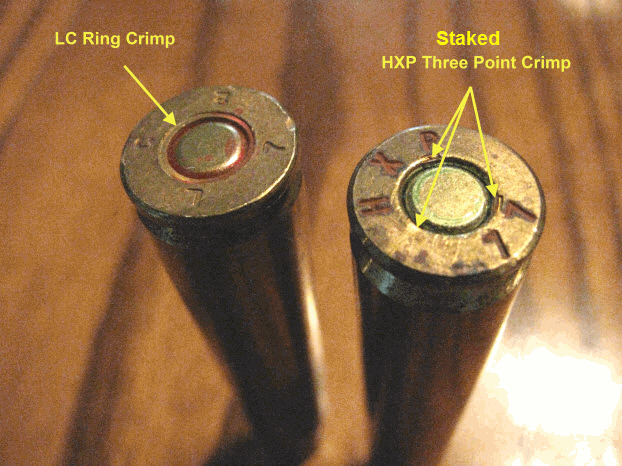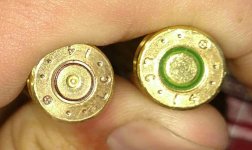You are using an out of date browser. It may not display this or other websites correctly.
You should upgrade or use an alternative browser.
You should upgrade or use an alternative browser.
Is this primer crimped?
- Thread starter KBrun
- Start date
The color is lacquer moisture sealant.
LC always uses ring crimps. These are the the thin steps around the perimeters of your primer pockets. They were made by a crimping ram pressing that step into the brass.

I'm going to edit your image down to something that will fit on most people's screens. Figure about 800 pixels wide for that.
LC always uses ring crimps. These are the the thin steps around the perimeters of your primer pockets. They were made by a crimping ram pressing that step into the brass.

I'm going to edit your image down to something that will fit on most people's screens. Figure about 800 pixels wide for that.
Reloader54
New member
Some ammo manufacturing companies put some type of sealant around the primers. They do it to keep moisture out. But it does not mean that the shell casing has a locking ring in it. I've seen this on some of the ammo when I reload mine own.I have some 7.62 that I think may have crimped primer pockets. When you look at them you can see a ring if green or pink. It is federal xm80cl.

Here is a fired and unfired picture. Anyone know about it?
To add to Unclenick's post, LC is great brass but requires a little extra work to prep. Of course the crimp has to be removed and it can be tough to resize the first time as it's often fired in loose chambers (think machine guns). The case walls are thick so start at the minimum powder charge and don't be surprised if you see pressure signs well below max.
Don't let those things deter you. LC is very consistent, tough brass and my favorite after Lapua.
Don't let those things deter you. LC is very consistent, tough brass and my favorite after Lapua.
So I just finished the first step of load Development with other brass. I'm partly tempted to start using the lc brass because of cheap availability. Worth the extra work? And what do I need to do to prep it?To add to Unclenick's post, LC is great brass but requires a little extra work to prep. Of course the crimp has to be removed and it can be tough to resize the first time as it's often fired in loose chambers (think machine guns). The case walls are thick so start at the minimum powder charge and don't be surprised if you see pressure signs well below max.
Don't let those things deter you. LC is very consistent, tough brass and my favorite after Lapua.
Nothing really special other than removing the crimp. There are tools that swage and those that ream. I ream with a bit made by Lyman for that purpose chucked in a drill press. Dillon makes a very nice swager but it's pricey unless you have a LOT of brass to do. Google "primer crimp removal". And, as I said, the initial sizing can be tough. The brass walls are thick and are often quite over sized.
Other than that, it's the same as prepping commercial brass.
Other than that, it's the same as prepping commercial brass.
Lake City to NATO spec (cross in a circle)
Yes its crimped, possibly hidden under the primer sealer.
If you're dong a few then the hand tool bit for your cleaning brush handle will be fine. Or the chamfer end of your chamfer/deburr tool.
If its a lot invest in a die or dedicated crimp removing tool.
Yes its crimped, possibly hidden under the primer sealer.
If you're dong a few then the hand tool bit for your cleaning brush handle will be fine. Or the chamfer end of your chamfer/deburr tool.
If its a lot invest in a die or dedicated crimp removing tool.
Lake City to NATO spec (cross in a circle)
Yes its crimped, possibly hidden under the primer sealer.
If you're dong a few then the hand tool bit for your cleaning brush handle will be fine. Or the chamfer end of your chamfer/deburr tool.
If its a lot invest in a die or dedicated crimp removing tool.
Thanks for the help. I'll probably pick up a tool then. My goal is to have a couple hundred of the same brass. This way I can get some range time, plus the 60 I have coat me 8 dollars a box. I can hardly buy new Hornady brass for that at BPS. This way I can get some trigger time also.Nothing really special other than removing the crimp. There are tools that swage and those that ream. I ream with a bit made by Lyman for that purpose chucked in a drill press. Dillon makes a very nice swager but it's pricey unless you have a LOT of brass to do. Google "primer crimp removal". And, as I said, the initial sizing can be tough. The brass walls are thick and are often quite over sized.
Other than that, it's the same as prepping commercial brass.
MarkGlazer
New member
I'm with burrhead. I too use the Lyman tool chucked in a power drill. You're simply talking about another step in the preparation process, but one you should be taking anyway. Each time I process .223/5.56 I place the Lyman bit into the flash hole. If it goes in smoothly, it's ready to move to the vibrating cleaner. If not, pull the trigger and clean out the crimp.
Patience was the hardest thing for me when I first started loading for rifle. I was so used to pistol which is essentially turn and burn for brass prep. Rifle has many more steps and they are time consuming but obviously necessary. Once you get into the routine it becomes logical to digest and get through.
Good luck. Be safe.
Patience was the hardest thing for me when I first started loading for rifle. I was so used to pistol which is essentially turn and burn for brass prep. Rifle has many more steps and they are time consuming but obviously necessary. Once you get into the routine it becomes logical to digest and get through.
Good luck. Be safe.
Marco Califo
New member
If you are going to reload once fired LC 7.62/308, yes, they are crimped and yes you will need to remove it. This brass is cheap because it is ALL fired in machine guns, which are the only weapons which use 7.62/308, except some special purpose arms. The firing in machine guns puffs them out in the loose chambers used to keep machine guns firing. It can be a challenge to resize:
1. Deprime
2. Clean in detergent or tumble
3. Resize well lubed cases. I prefer White Lithium grease. The expander assembly can be removed for this step. I like to drop the case into a case gage after each sizing. Actually, checking with the gage convinced me to always resize with the small base die.
4. I then resize again, using a small base die the second time, with the expander assembly in place.
5. Tumble off the lube.
6. You will need to trim as case lengths will now be all over the place with some 20/1000 or more too long.
7. Optionally, for improved accuracy you could then weigh and sort your cases. All cases from the same lot that weigh close to the same will have very similar case capacities.
Is it worth it? I say yes. But,
I have not thrown out my commercial brass.
1. Deprime
2. Clean in detergent or tumble
3. Resize well lubed cases. I prefer White Lithium grease. The expander assembly can be removed for this step. I like to drop the case into a case gage after each sizing. Actually, checking with the gage convinced me to always resize with the small base die.
4. I then resize again, using a small base die the second time, with the expander assembly in place.
5. Tumble off the lube.
6. You will need to trim as case lengths will now be all over the place with some 20/1000 or more too long.
7. Optionally, for improved accuracy you could then weigh and sort your cases. All cases from the same lot that weigh close to the same will have very similar case capacities.
Is it worth it? I say yes. But,
I have not thrown out my commercial brass.
m&p45acp10+1
New member
If you happen to come into new LC brass it is ready to go without the crimp. I quit wasting time trying to figure out if brass had crimps or not. I have a Lyman reamer in an electric screw driver. Two seconds of work no crimp. If there was one it is gone. If there was not one then it will not cut away any brass. If you are looking for another way to check then get a primer pocket cleaner. The one that looks like the end of a flat head screw driver. If it goes to the bottom of the primer pocket then it is not crimped. If it does not then you know it is crimped.
This ammo is new, once fired out of my gun. I resized a couple yesterday and they were no more difficult to do then the Winchester brass I had before. I may try to pick up another 4 or 5 boxes on sale to shoot up. Since the loaded ammo is cheaper then a lot of brass, seems like a good deal to me,
m&p45acp10+1
New member
I should clarify my previous statement. New unprimed LC brass is not crimped. The loaded stuff is.
Both cases in the pic appear to be crimped (annular crimp). Process just like any other brass but with one added step. Removing the primer crimp. Some will use a dedicated reloading tool for crimp removal (reamers, pocket "reformers", and swages), but being a lifelong machinist/mechanic I prefer a simple counter sink, 60 degree (available at most good hardware stores for $8.00-$15.00...
After using the RCBS primer pocket swager for some time, and never being really happy with it, I just went with sticking the nose of my deburring tool in the pocket and giving a couple twists.
Works fine for me, and as long as I don't do too many in a row without a break, I don't get hand cramps.
It is a ONE TIME process, and you could use a pocket knife if you want.
Works fine for me, and as long as I don't do too many in a row without a break, I don't get hand cramps.
It is a ONE TIME process, and you could use a pocket knife if you want.
WVMountaineer
New member
CH4D swage tool. Awesome, affordable, and it WORKS very well and is fast. No need to buy a name. But what works. and these do very well. God Bless

